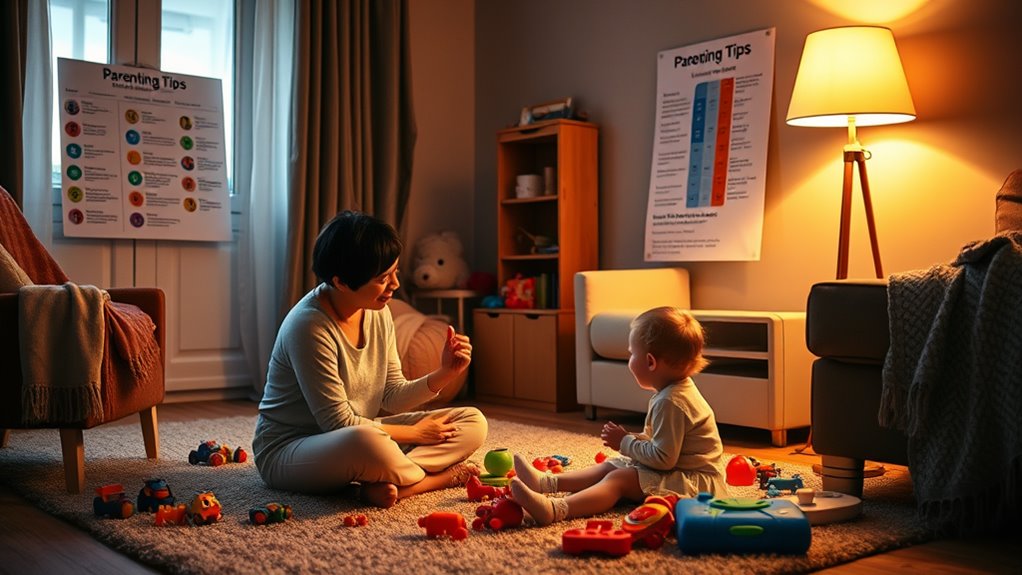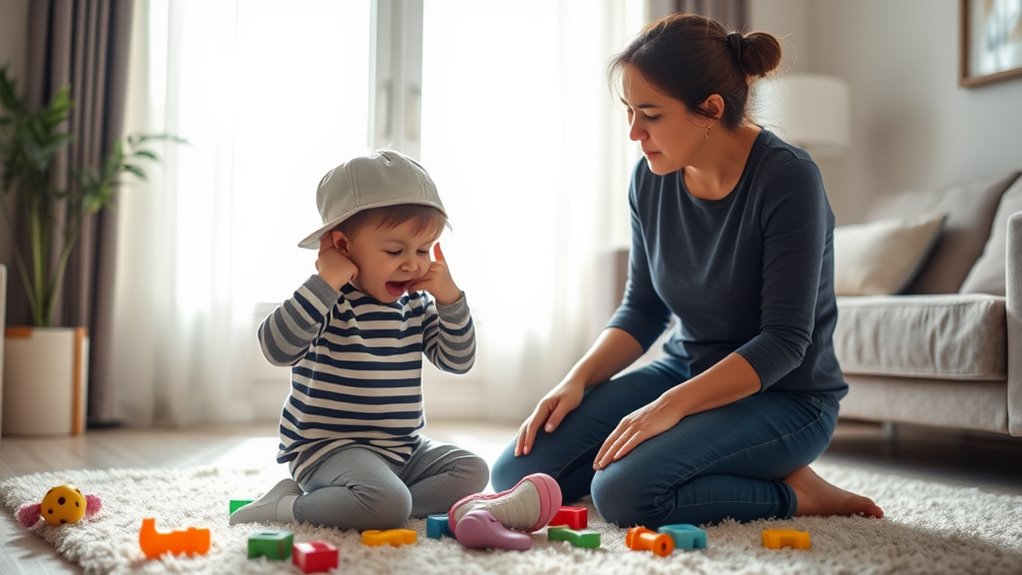To communicate effectively with your kids, try using active listening. That means giving them your full attention, making eye contact, and even reflecting their feelings back to them, like saying, “So, you’re feeling sad about your friend?” It helps to ask open-ended questions too, like “What’s your favorite game?” and encourages dialogue. Use positive language, focusing on what they can do. And don’t forget non-verbal cues—your facial expressions and body language matter! Building trust takes patience, so keep the lines open and remember, a little humor goes a long way. Stick around, there’s even more to discover!
Active Listening Techniques
Active listening techniques are essential for fostering strong communication between you and your child. When you really listen, you show them that their thoughts and feelings matter.
So, what does active listening look like? First, give them your full attention. Put down that phone or pause the TV—your child deserves a moment of your undivided focus.
Next, maintain eye contact. It shows you’re interested and helps them feel valued. You might even nod along as they speak; it’s like saying, “I’m with you!”
Don’t forget to reflect back what they’ve said. You can say something like, “So, you’re feeling upset about that test?” This not only confirms you’re listening but also encourages them to share more.
Ask open-ended questions, too! Instead of, “Did you like school today?” try, “What was the best part of your day?” This invites them to express themselves more freely.
Lastly, be patient. Sometimes kids need a little time to gather their thoughts. A little pause can work wonders, and hey, it gives you a chance to think about what you might say next!
Encouraging Open Dialogue
Creating an environment that encourages open dialogue with your child is essential for building trust and understanding. You want your child to feel comfortable sharing their thoughts, feelings, and even silly secrets. One way to do this is by being available and approachable. When your child knows you’re there to listen, they’re more likely to open up.
Try to ask open-ended questions that invite conversation. Instead of just asking, “Did you have a good day?” you might say, “What was the best part of your day?” This way, you’re encouraging them to share more than just a yes or no answer.
It’s also important to show that you value their opinions. When they share something, respond with interest and empathy. If they talk about a tough situation, instead of jumping straight into advice mode, say something like, “That sounds really hard. How did that make you feel?”
And don’t forget to share your thoughts too! When you let them in on your experiences, it creates a two-way street of communication.
Non-Verbal Communication Cues
While encouraging open dialogue is key, non-verbal communication cues play a significant role in how messages are received and understood. You mightn’t realize it, but your body language, facial expressions, and even eye contact can say a lot!
For instance, when you’re talking to your child, crossing your arms might seem like a protective stance, but it can also come off as being closed off or defensive. Instead, try to keep your arms relaxed and open to show you’re approachable.
Facial expressions are equally important. A smile can make your child feel safe and loved, while a frown might make them hesitate to share their feelings.
Eye contact is another biggie; it shows you’re engaged and interested in what they’ve to say.
Using Positive Language
Positive language can transform the way you communicate with your child, making a substantial difference in their emotional response. Instead of saying “Don’t run,” try “Please walk.” This simple change encourages your child to understand what they should do, rather than what they shouldn’t. It’s like giving them a helpful roadmap instead of a confusing roadblock!
When you use positive language, you’re not just guiding behavior; you’re also boosting their self-esteem. Phrases like “I love how you shared your toys” show appreciation and encourage your child to repeat those behaviors. Complimenting their efforts, rather than focusing solely on results, helps them feel valued.
You can also sprinkle in some humor to keep things light! For instance, if they spill juice, instead of a stern “Why’d you do that?” try saying, “Looks like the juice wanted to take a swim!” This approach can turn a messy situation into a giggle, making it easier for them to learn from their mistakes.
Setting Clear Expectations
And remember, it’s okay to keep a light-hearted atmosphere.
A little humor can ease the tension when expectations are high.
Practicing Empathy
Setting clear expectations creates a solid foundation for your relationship with your child, but it’s equally important to connect on an emotional level. Practicing empathy helps you understand your child’s feelings and thoughts, making them feel valued. When they share their worries or joys, listen actively and respond with kindness. Try saying, “I can see you’re upset,” or “That sounds really exciting!” This shows you’re tuned into their emotions.
Remember, your child wants to know you care. You don’t have to solve all their problems; sometimes, just being there makes a world of difference. Imagine your child feels nervous about a big test. Instead of saying, “You’ll be fine,” try, “It’s okay to feel nervous. Let’s talk about it.” This way, you’re inviting them to open up and feel understood.
Also, don’t forget to share your feelings too! Let them know when you’re happy, proud, or even a little frustrated. This creates a safe space for them to express themselves.
With empathy, you build trust, and your child will be more likely to share their thoughts with you in the future. And who knows? You might even learn a thing or two along the way!
Timing and Environment
While you may have the best intentions, the timing and environment in which you communicate with your child can greatly impact how effective your message is.
Imagine trying to talk to your child about something important while they’re in the middle of a game or snack time. Chances are, their attention might be elsewhere! Picking a good time is key. Try to chat when your child is relaxed and not distracted, like during a quiet evening or after school.
The environment matters too. A cozy spot, like the living room or a favorite park, can make a big difference. If you’re sitting on a park bench, enjoying some sunshine, your child might feel more at ease to open up.
Keep the noise level in mind, too—too much background noise can drown out your words.
Conflict Resolution Strategies
Even in a relaxed setting, conflicts can arise between you and your child. It’s just part of parenting. When disagreements happen, staying calm is key. Take a deep breath and remind yourself that resolving the issue is more important than winning.
Start by listening. Let your child express their feelings without interrupting. You’d be surprised how much they just want to be heard!
Next, acknowledge their feelings. You might say, “I understand you’re upset.” This shows you care, and it can help lower the tension.
Then, try to find a compromise together. Ask, “What can we do to make this better?” This turns the conflict into a team effort, which is much more fun!
If emotions run high, it’s okay to take a break. A little time apart can help both of you cool down. Later, you can revisit the issue with fresh minds.
Remember, conflict resolution isn’t about who’s right or wrong; it’s about understanding each other.
Lastly, don’t forget to sprinkle in a little humor when possible. A light-hearted comment can lighten the mood and remind you both that it’s okay to disagree sometimes!
Age-Appropriate Communication
When you communicate with your child, it’s important to match your approach to their age and developmental stage. Each age brings unique ways of thinking and understanding, so what works for a toddler might baffle a teenager!
For younger kids, keep it simple. Use short sentences and clear words. You can even add a fun tone or silly voices to grab their attention. Kids love that!
As children grow, they start asking more questions, so encourage their curiosity. Instead of giving one-word answers, share a little more detail. This helps them feel included and valued in the conversation.
With teenagers, it’s all about listening. They want to express themselves, so give them space to share their thoughts, even if they seem a bit dramatic.
Building Trust and Safety
To foster a strong bond with your child, you need to create an environment of trust and safety. When kids feel safe, they’re more likely to open up and share their thoughts and feelings.
Start by being consistent in your words and actions. If you say you’ll be there for them, show up! Kids notice everything, so your reliability builds their trust.
Encourage open communication by letting your child know that it’s okay to express their feelings, even the tough ones. Make sure they understand that you won’t judge them for what they share.
Creating a safe space means listening actively, without interrupting or dismissing their concerns. You can even try using silly examples from your own life to lighten the mood—after all, everyone makes mistakes!
Setting clear boundaries also plays an essential role. Kids need to know what’s expected of them, and that you’re there to guide them.
When they know you care about their well-being, it strengthens that bond. Remember, trust isn’t built overnight, but with patience and love, you’ll create a lasting foundation that helps your child feel secure and valued.





